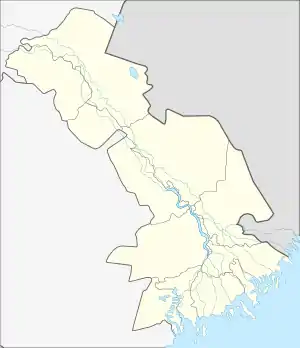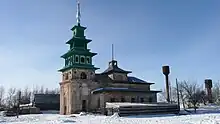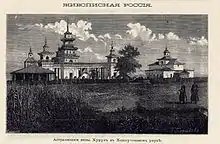Хошеутовский хурул | |
_%D0%BA%D0%B0%D0%BB%D0%BC%D1%8B%D1%86%D0%BA%D0%B8%D0%B9_%D0%A5%D0%BE%D1%88%D0%B5%D1%83%D1%82%D0%BE%D0%B2%D1%81%D0%BA%D0%BE%D0%B3%D0%BE_%D1%85%D1%83%D1%80%D1%83%D0%BB%D0%B0%252C_%D0%A0%D0%B5%D1%87%D0%BD%D0%BE%D0%B5%252C_%D0%90%D1%81%D1%82%D1%80%D0%B0%D1%85%D0%B0%D0%BD%D1%81%D0%BA%D0%B0%D1%8F_%D0%BE%D0%B1%D0%BB%D0%B0%D1%81%D1%82%D1%8C%252C_%D0%B2%D0%B8%D0%B4_%D1%81%D0%BE_%D1%81%D1%82%D0%BE%D1%80%D0%BE%D0%BD%D1%8B_%D1%81%D0%B5%D0%BB%D0%B0.jpg.webp) The khurul as seen from the village of Rechnoye | |
 Location within Astrakhan Oblast | |
| Monastery information | |
|---|---|
| Order | Gelug |
| Denomination | Tibetan Buddhism |
| Established | 1818 |
| Disestablished | 1920s |
| Reestablished | 1990s[1] |
| People | |
| Founder(s) | Serebdzhab Tyumen |
| Architecture | |
| Heritage designation | Cultural Heritage of Russia |
| Designated date | February 20, 1995 |
| Architect | Batur-Ubushi Tyumen (Батур-Убуши Тюмень) & Gavan Dzhimba (Гаван Джимба) |
| Groundbreaking | 1814 |
| Completion date | 1817-1818 |
| Site | |
| Location | Rechnoye, Astrakhan Oblast |
| Country | Russia |
| Coordinates | 46°55′38″N 47°36′48.9″E / 46.92722°N 47.613583°E |
| Public access | Yes |
Khosheutovsky khurul (Russian: Хошеу́товский хуру́л) is a Buddhist monastery of the early 19th century and an architectural and historical monument of federal significance.[2][3] The khurul is located in the village of Rechnoye, Kharabalinsky District, Astrakhan Oblast. It is the only partially preserved Kalmyk khurul from pre-revolutionary times.[4]
History

Foundation
In the past, there used to be a wooden temple on the site of the Khosheutovsky khurul, in which a divine service took place in honor of the Second Kalmyk Regiment, which participated in the Patriotic War of 1812 and the foreign campaigns of the Russian army;[5] The regiment's banner was also kept in this temple.[6] The construction of the Khosheutovsky khurul was initiated by the owner of the Khosheutovsky ulus, hero of the Patriotic War of 1812, Lieutenant Colonel Serebdzhab Tyumen, who wanted to build a memorial complex in memory of the Kalmyks who participated in the war;[7] The monk Gavan Chombe became Tyumen's consultant.[5] The Khosheutovsky khurul was built according to the design of Batur-Ubushi Tyumen. Construction of the khurul began in 1814 on the site of the old Buddhist temple and was completed in 1817-1818.[7]
Battle flags of the Kalmyks were enshrined in the khurul. One of them depicted a rider on a white horse — Daichin-Tengri — in the Palden Lhamo style.[8] On October 17-18, 1858, the khurul was visited by Alexandre Dumas, who was staying with Serebdzhab Tyumen at that time.[7]
During Soviet rule

The Khosheutovsky khurul was closed during the 1920s.[5] The following decade the khurul was used as a kindergarten, then as a school, and in the 1950s as a granary. Eventually, the gallery and small towers of the khurul were deconstructed, for the local kolkhoz was in need for bricks to build a cowshed in the 1960s.[1] Later on, the remaining part of the khurul was abandoned and gradually began to collapse.[9] Furthermore, after the beginning of the deportation of Kalmyks in 1944, the territory the Khosheutovsky khurul is located on was transferred from the then abolished Kalmyk ASSR to the Astrakhan Oblast. After the reestablishment of the Kalmyk ASSR in 1957 and the return of the Kalmyks to that region, the Kalmyks stated the need to return the Khosheutovsky khurul onto Kalmyk territory given its historical and cultural significance for the Kalmyk people.[5]
Restoration
_%D0%BA%D0%B0%D0%BB%D0%BC%D1%8B%D1%86%D0%BA%D0%B8%D0%B9_%D0%A5%D0%BE%D1%88%D0%B5%D1%83%D1%82%D0%BE%D0%B2%D1%81%D0%BA%D0%BE%D0%B3%D0%BE_%D1%85%D1%83%D1%80%D1%83%D0%BB%D0%B0%252C_%D0%A0%D0%B5%D1%87%D0%BD%D0%BE%D0%B5%252C_%D0%90%D1%81%D1%82%D1%80%D0%B0%D1%85%D0%B0%D0%BD%D1%81%D0%BA%D0%B0%D1%8F_%D0%BE%D0%B1%D0%BB%D0%B0%D1%81%D1%82%D1%8C%252C_%D0%B2%D0%B8%D0%B4_%D1%81%D0%BE_%D1%81%D1%82%D0%BE%D1%80%D0%BE%D0%BD%D1%8B_%D1%80%D0%B5%D0%BA%D0%B8.jpg.webp)
In the Kalmyk ASSR, in Elista, after a meeting of the organizing committee held on October 23, 1990, at the Astrakhan Museum of Local Lore, the main scope of work on the restoration was approved, the necessary cost estimate for restoration was determined and the significance of this architectural monument was emphasized.[10]
Restoration work of varying degrees of complexity was carried out in the khurul from 1991 to 2014. The initiators were the Astrakhan Museum of Local Lore and the Astrakhan society of local history. In 1996, the initiative group founded the Astrakhan branch of the International League for the Protection of Culture, headed by E.V. Rozhkova. The league united Astrakhan Buddhists, local historians, and representatives of the Society of National Kalmyk Culture in the fight for the preservation of the khurul. The Museum of Local Lore proposed to open a museum in the restored khurul in 1995, which was supposed to become a center for scientific and educational work, telling about the history of Buddhism and the peoples inhabiting the Astrakhan region. A project for future exhibitions was developed, including "Khosheutovsky khurul - a monument of history and culture".[11]
On August 7, 2004, a decision was made to transfer the khurul for free use to the local Buddhist community.[12] At the same time, a board of trustees was convened in Elista to restore the Khosheutovsky khurul. The first works started in 2009 with the restoration and painting of the top of the main building. Around 2011, the entire pagoda was restored.[13]
Current state
As an architectural and historical monument of federal significance, Khosheutovsky khurul is under federal protection.[3] The contemporary khurul contains a partially preserved original painting.[9]
Architecture

The architecture of the khurul combines the features of Russian classicism and the traditional Kalmyk style. The basis for the composition of the khurul was the plan of the Kazan Cathedral in St. Petersburg; Moreover, the composition resembles the Khoshut tamga in the form of an arrow and a bow.[5] The tamga was also imprinted on almost every brick of the khurul during its construction. According to Sergei Lyubimov, the nomadic khuruls Dekshidyn and Manlan were settled down around the Khosheutovsky khurul. They arrived from Dzungaria in 1811. A lithograph by an unknown artist from 1868 shows that both nomadic khuruls had stone syumes[lower-alpha 1] built for them, located to the left and right of the main building. At the beginning of the 20th century, the monastery complex, in addition to the main building and the syume of the nomadic khuruls, included a mani (a chapel with a prayer wheel, Kalmyk: кюрдэ, romanized: kyurde), several stupas, a court chapel of a Noyan and the dwellings of servants. Lyubimov noted that the monastery looked picturesque.[6] By the beginning of the 21st century, only the chapel and the central building remained from the monastery complex; the galleries extending from it were also lost.[15]
See also
- Khurul — the Kalmyk term for Buddhist monasteries
- Buddhism in Kalmykia
- Buddhism in Russia
- Burkhan Bakshin Altan Sume
- Geden Sheddup Choikorling Monastery
Notes
- ↑ Syume — quadrangular monastery in Tibetan Buddhism[14]
References
- 1 2 Балакаева, Надежда (2009). "Хошеутовский хурул должен стоять в Калмыкии" [The Khosheutovsky khurul must be in Kalmykia]. savetibet.ru (in Russian). Retrieved 2023-09-10.
- ↑ "Калмыцкий хурул (хошеутовский)" [Kalmyk khurul (Khosheutovsky)] (in Russian). Ministry of Culture (Russia). Archived from the original on 2016-04-06.
- 1 2 "Калмыцкий хурул, 1818 г." [Kalmyk khurul, year 1818] (in Russian). Ministry of Culture (Russia). 2023-07-13. Retrieved 2023-09-09.
- ↑ Тодар Бактемир (2021-05-19). В Астрахани построят буддийский храм [A Buddhist temple will be built in Astrakhan] (in Russian). Retrieved 2023-09-10.
- 1 2 3 4 5 Бакаева, Эльза Петровна (1992). Игнатович, Александр Николаевич [in Russian]; Корнев, Владимир Иванович [in Russian]; Жуковская, Наталия Львовна [in Russian] (eds.). Буддизм. Словарь [Buddhism. Dictionary] (in Russian). Moscow: Respublika. p. 261.
- 1 2 Любимов, Сергей Васильевич [in Russian] (1915). Князья Тюменевы [The Tyumenyev Knyazes] (in Russian). Stavropol: Типография Ставропольской губернии.
- 1 2 3 Илишкин, Лари Наранович (2004). Знаменитые калмыки прошлого [Famous Kalmyks of the past] (in Russian). Elista: Джангар. p. 27. ISBN 5-94587-043-9.
- ↑ Шараева, Татьяна Исаевна (2012). К вопросу о калмыцких боевых знаменах [On the issue of Kalmyk battle banners]. Oriental Studies [Вестник КИГИ РАН] (in Russian). Elista: Калмыцкий институт гуманитарных исследований РАН (2): 52–56. ISSN 2619-1008. Retrieved 2023-09-10.
- 1 2 "Земля – кормилица" [The Earth – the feeder] (docx) (in Russian). Администрация муниципального образования «Харабалинский район» [Administration of the municipality of "Kharabalinsky District"]. Retrieved 2023-09-10.
- ↑ "Хошеутовский хурул" [Khosheutovsky khurul]. Парус (in Russian).
- ↑ Третьякова, Яна (2016-04-18). Хошеутовский хурул: старейший буддийский храм Европы. И его вторая жизнь [Khosheutovsky khurul: the oldest Buddhist temple in Europe. And its second life]. astrakult.ru (in Russian). Retrieved 2023-09-10.
- ↑ Курапов, А. (2012-06-20). Хошеутовский хурул [Khosheutovsky khurul]. Познание запредельного (in Russian).
- ↑ Халгинова, Нелли (2018-08-21). Хошеутовский хурул как память о погибших воинах и лучших людях России [Khosheutovsky khurul as a memory of fallen warriors and the best people of Russia]. Степные вести / Теегин зянг (in Russian). Retrieved 2023-09-10.
- ↑ Плужников, Владимир Иванович [in Russian] (1995). Термины российского архитектурного наследия: Словарь-глоссарий [Terms of Russian architectural heritage: Dictionary-glossary] (in Russian). Moscow: Искусство. p. 158. ISBN 5-210-01984-5.
- ↑ Омакаева, Эллара Уляевна; Сампилдондов, Чулуун; Бадгаев, Николай Боктаевич; Горяева, Полина Борисовна; Бадгаева, Дарина Николаевна (2020). "Географические особенности становления Хошеутовского хурула как наследия калмыцкого народа" [Geographical characteristics of the formation of the Khosheutovsky khurul as a heritage of the Kalmyk people]. Международный журнал прикладных наук и технологий «Integral» (in Russian) (1): 98–106. doi:10.24411/2658-3569-2020-10008.
External links
- Website, dedicated to the Khosheutovsky khurul (Russian, English)
- Khosheutovsky khurul (Russian)
- The abandoned khurul of khan Tyumen (Russian)
- Khosheutovsky khurul (Russian)